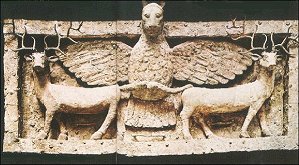What all this implies is of particular significance to the student, not merely of such hieratic arts as those of India or the Middle Ages, but of folk and savage art, and of fairy tales and popular rites; since it is precisely in all these arts that the parabolic or symbolic style has best survived in our otherwise self-expressive environment. Archeologists are indeed beginning to realise this. Strzygowski, for example, discussing the conservation of ancient motifs in modern Chinese peasant embroideries, endorses the dictum that “the thought of many so-called primitive peoples is far more spiritualised than that of many so-called civilised peoples,” adding that “in any case, it is clear that in matters of religion we shall have to drop the distinction between primitive and civilised peoples.”1The art historian is being left behind in his own field by the archeologist, who is nowadays in a fair way to offer a far more complete explanation of the work of art than the aesthetician who judges all things by his own standards. The archeologist and anthropologist are impressed, in spite of themselves, by the antiquity and ubiquity of formal cultures by no means inferior to our own, except in the extent of their material resources.
 It is mainly our infatuation with the idea of “progress” and the conception of ourselves as “civilised” and of former ages and other cultures as being “barbarous”2that has made it so difficult for the historian of art—despite his recognition of the fact that all “art cycles” are in fact descents from the levels attained by the “primitives,” if not indeed descents form the sublime to the ridiculous—to accept the proposition that an “art form” is already a defunct and derelict form, and strictly speaking a “superstition,” i.e. a “stand over” from a more intellectual humanity that our own; in other words, exceedingly difficult for him to accept the proposition that what is for us a “decorative motif” and a sort of upholstery is really the Vestage of a more abstract mentality than our own, a mentality that used less means to mean more, and that made use of symbols primarily for their intellectual values, and not as we do, sentimentally.3We say here “sentimentally,” rather than “aesthetically,” reflecting that both words are the same in their literal significance, and both equivalent to “materialistic”; aesthesis being “feeling,” sense the means of feeling, and “matter” what is felt. To speak of an aesthetic experience as “distinterested” really involves an antimony; it is only a noetic or cognitive experience that can be disinterested. For the complete appreciation or experiencing of a work of traditional art (we do not deny that there are modern works of art that only appeal to the feelings) we need at least as much to eindenken as to einfühlen to “think-in” and “think-with” at least as much as to “feel-in” and “feel-with.”
It is mainly our infatuation with the idea of “progress” and the conception of ourselves as “civilised” and of former ages and other cultures as being “barbarous”2that has made it so difficult for the historian of art—despite his recognition of the fact that all “art cycles” are in fact descents from the levels attained by the “primitives,” if not indeed descents form the sublime to the ridiculous—to accept the proposition that an “art form” is already a defunct and derelict form, and strictly speaking a “superstition,” i.e. a “stand over” from a more intellectual humanity that our own; in other words, exceedingly difficult for him to accept the proposition that what is for us a “decorative motif” and a sort of upholstery is really the Vestage of a more abstract mentality than our own, a mentality that used less means to mean more, and that made use of symbols primarily for their intellectual values, and not as we do, sentimentally.3We say here “sentimentally,” rather than “aesthetically,” reflecting that both words are the same in their literal significance, and both equivalent to “materialistic”; aesthesis being “feeling,” sense the means of feeling, and “matter” what is felt. To speak of an aesthetic experience as “distinterested” really involves an antimony; it is only a noetic or cognitive experience that can be disinterested. For the complete appreciation or experiencing of a work of traditional art (we do not deny that there are modern works of art that only appeal to the feelings) we need at least as much to eindenken as to einfühlen to “think-in” and “think-with” at least as much as to “feel-in” and “feel-with.”
The aesthetician will object that we are ignoring both the question of artistic quality, and that of the distinction of a noble from a decadent style. By no means. We merely take it for granted that every serious student is equipped by temperament and training to distinguish good from bad workmanship. And if there are noble and decadent periods of art, despite the fact that workmanship may be as skilful or even more skilful in the decadent than in the noble period, we say that the decadence is by no means the fault of the artist as such (the “maker by art”), but of the man, who in the decadent period has so much more to say, and means so much less. More to say, the less to mean—this is a matter, not of formal, but of final causes, implying defect, not in the artist, but in the patron.”4
 We say, then, that the “scientific” art historian, whose standards of explanation are altogether too facile and too merely sensitive and psychological, need feel no qualms about the “reading of meanings into” given formulae. When meanings, which are also raisons d’être, have been forgotten, it is indispensable that those who can remember them, and can demonstrate by reference to chapter and verse the validity of their “memory,” should re-read meanings into forms from which the meaning has been ignorantly “read out,” whether recently or long ago. For in no other way can the art historian be said to have fulfilled his task of fully explaining and accounting for the form, which he has not invented himself, and only knows of as an inherited “superstition.” It is not as such that the reading of meanings into works of art can be criticised, but only as regards the precision with which the work is done; the scholar being always, of course, subject to the possibility of self-correction or of correction by his peers, in matters of detail, though we may add that in case the iconographer is really in possession of his art, the possibilities of fundamental error are rather small. For the rest, with such “aesthetic” mentalities as ours, we are in little danger of proposing over-intellectual interpretations of ancient works of art.
We say, then, that the “scientific” art historian, whose standards of explanation are altogether too facile and too merely sensitive and psychological, need feel no qualms about the “reading of meanings into” given formulae. When meanings, which are also raisons d’être, have been forgotten, it is indispensable that those who can remember them, and can demonstrate by reference to chapter and verse the validity of their “memory,” should re-read meanings into forms from which the meaning has been ignorantly “read out,” whether recently or long ago. For in no other way can the art historian be said to have fulfilled his task of fully explaining and accounting for the form, which he has not invented himself, and only knows of as an inherited “superstition.” It is not as such that the reading of meanings into works of art can be criticised, but only as regards the precision with which the work is done; the scholar being always, of course, subject to the possibility of self-correction or of correction by his peers, in matters of detail, though we may add that in case the iconographer is really in possession of his art, the possibilities of fundamental error are rather small. For the rest, with such “aesthetic” mentalities as ours, we are in little danger of proposing over-intellectual interpretations of ancient works of art.
- Strzygowski, J., Spuren indogermanischen Glaubens in der bildenden Kunst, 1936, p. 334. [↩]
- Gleizes, A., Vie et Mort de I’Occident chrétien, Sablons (1936), p. 60 “Deux mots, barbarie et civilisation, sont à la base de tout developpement historique. Ils donnent à la notion de progrès la continuité qu’on lue désire sur tous les terrains particuliers en évaillant l’idée d’infériorité et de supériorité. Ils nous débarrassent de tout souci d’avenir, la barbarie etant derrière nous et la civilisation s’améliorant chaque jour.” I cite these remarks not so much in confirmation, as to call attention to the works of M. Gleizes, himself a painter, but who says of himself “Mon artje I’ai voulu métier … Ainsi, je pense ne pas être humainement inutile.” M. Gleizes’ most considerable work is La Forme et I’Histoire; vers une Conscience Plastique, Paris, 1932 [↩]
- Despite the recognition of a typical “descent,” the notion of a meliorative “progress” is so attractive and so comfortably supports an optimistic view of the future that one still and in face of all the evidence to the contrary fancies that primitive man and savage races “drew like that” because they “could not” represent natural effects as we represent them; and in this way it becomes possible to treat all “early” forms of art as striving towards and preparing the way for a more “mature” development; to envisage the supercession of form by figure as a favourable “evolution.” In fact, however, the primitive “drew like that” because he imagined like that, and like all artists, wished to draw as he imagined; he did not in our sense “observe,” because he had not in view the statement of singular facts; he “imitated” nature, not in her effects, but in her manner of operation. Our “advance” has been from the sublime to the ridiculous. To complain that primitive symbols do not look like their referents is as naive as it would be to complain of a mathematical equation, that it does not resemble the locus it represents. [↩]
- It is extraneous of the business to the art historian or curator, as such, to distinguish noble from decadent styles; the business of these persons as such is to know what is good of its kind, exhibit, and explain it. At the same time, it is not enough to be merely an art historian or merely a curator; it is also the business of man as patron, to distinguish a hierarchy of values in what has been made, just as it is his business to decide what it is worth while to make now. [↩]